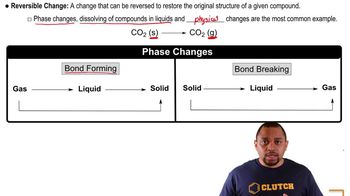Consider the reaction A + B → C + D. Is each of the following statements true or false? (b) If the reaction is an elementary reaction, the rate law is second order.
Ch.14 - Chemical Kinetics
Chapter 14, Problem 89c
Consider the reaction A + B → C + D. Is each of the following statements true or false? (c) If the reaction is an elementary reaction, the rate law of the reverse reaction is first order.
 Verified step by step guidance
Verified step by step guidance1
insert step 1> Understand that an elementary reaction is a single-step process where the rate law can be directly written from the stoichiometry of the reaction.
insert step 2> For the given reaction A + B → C + D, if it is an elementary reaction, the rate law for the forward reaction is rate = k[A][B], where k is the rate constant.
insert step 3> Consider the reverse reaction C + D → A + B. If this reverse reaction is also elementary, its rate law can be written directly from its stoichiometry.
insert step 4> The rate law for the reverse reaction would be rate = k'[C][D], where k' is the rate constant for the reverse reaction.
insert step 5> Since the rate law for the reverse reaction depends on the concentration of two reactants, C and D, it is second order, not first order. Therefore, the statement is false.

Verified video answer for a similar problem:
This video solution was recommended by our tutors as helpful for the problem above.
Video duration:
1mWas this helpful?
Key Concepts
Here are the essential concepts you must grasp in order to answer the question correctly.
Elementary Reactions
An elementary reaction is a single step process in which reactants are converted to products in a single transition state. The rate law for an elementary reaction can be directly derived from its stoichiometry, meaning the rate is proportional to the concentration of the reactants raised to the power of their coefficients in the balanced equation.
Recommended video:
Guided course

Reaction Mechanism Overview
Rate Laws
Rate laws express the relationship between the rate of a chemical reaction and the concentration of its reactants. For elementary reactions, the rate law is straightforward, while for complex reactions, it may involve intermediates and cannot be directly inferred from stoichiometry. The order of the reaction indicates how the rate is affected by the concentration of reactants.
Recommended video:
Guided course

Rate Law Fundamentals
Reverse Reactions
The reverse reaction is the process in which products are converted back into reactants. For an elementary reaction, if the forward reaction is first order with respect to a reactant, the reverse reaction will also exhibit a specific order based on the stoichiometry of the products. Understanding the relationship between forward and reverse reactions is crucial for determining the rate laws of both directions.
Recommended video:
Guided course

Reversible Changes in Matter
Related Practice
Textbook Question
Textbook Question
The reaction 2 NO(g) + O2(g) → 2 NO2 (g) is second order in NO and first order in O2. When [NO] = 0.040 M, and [O2] = 0.035 M, the observed rate of disappearance of NO is 9.3⨉10-5 M/s. (b) What is the value of the rate constant?
Textbook Question
The reaction 2 NO(g) + O2(g) → 2 NO2 (g) is second order in NO and first order in O2. When [NO] = 0.040 M, and [O2] = 0.035 M, the observed rate of disappearance of NO is 9.3⨉10-5 M/s. (c) What are the units of the rate constant?
Textbook Question
The reaction 2 NO(g) + O2(g) → 2 NO2 (g) is second order in NO and first order in O2. When [NO] = 0.040 M, and [O2] = 0.035 M, the observed rate of disappearance of NO is 9.3⨉10-5 M/s. (d) What would happen to the rate if the concentration of NO were increased by a factor of 1.8?
